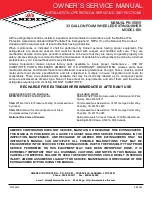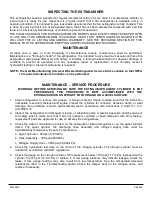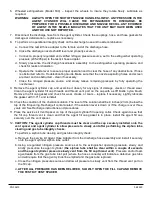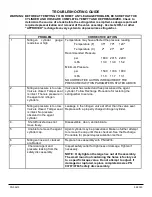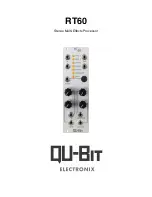
PN 05615
04/2020
TROUBLESHOOTING GUIDE
WARNING:
BEFORE ATTEMPTING TO CORRECT ANY LEAKAGE PROBLEM, BE SURE THAT THE
CYLINDER AND HOSE ARE COMPLETELY EMPTY AND DEPRESSURIZED. Check to
determine the source of a leak before the extinguisher is emptied. Leakage repairs will
require depressurization and removal of the valve assembly. Use Getz HR
-
1 or other
"APPROVED" recharge/recovery system to depressurize extinguisher.
PROBLEM
CORRECTIVE ACTION
1.
Nitrogen
cylinder
gauge
reads low or high
Temperature may have affected the pressure reading
Temperature (F)
35º
70º
120º
Temperature (C)
2º
21º
49º
Recommended Pressure
psi
1880
2015
2200
mPa
13.0
13.9
15.2
Minimum Pressure
psi
1590
1700
1900
mPa
11.0
11.7
13.1
NO CORRECTIVE ACTION IS REQUIRED IF THE
PRESSURE IS WITHIN PARAMETERS STATED ABOVE.
2.
Nitrogen pressure is too low.
Valve is closed. Tamper seal
is intact. There is pressure in
the agent and nitrogen
cylinders.
Valve seat has leaked and has pressurized the agent
cylinder. Follow Recharge Procedure for restoring the
extinguisher to service.
3.
Nitrogen pressure is too low.
Valve is closed. Tamper seal
is intact. No pressure
observed in the agent
cylinder.
Leakage in the nitrogen valve at other than the valve seal.
Replace with a properly charged nitrogen cylinder.
4.
Shutoff nozzle does not
move freely.
Disassemble, clean, and lubricate.
5.
Unable to remove the agent
cylinder cap.
Agent cylinder may be pressurized. Make no further attempt
to remove the cap until this is checked. See the Recharge
Procedure for proper depressurization method.
6.
Nitrogen hose cut, cracked
or abraded.
Replace hose assembly with PN 02234.
7.
Chemical agent and
pressure leaking from the
safety disc assembly.
Inspect safety outlet for tightness or damage. Tighten if
necessary.
NOTE: Only tighten the large hex nut of the assembly.
The small round nut containing the holes is factory set
to a specific torque value. Do not attempt to adjust. If
damaged or ruptured, replace complete Amerex PN
03787/07665 safety disc assembly.


